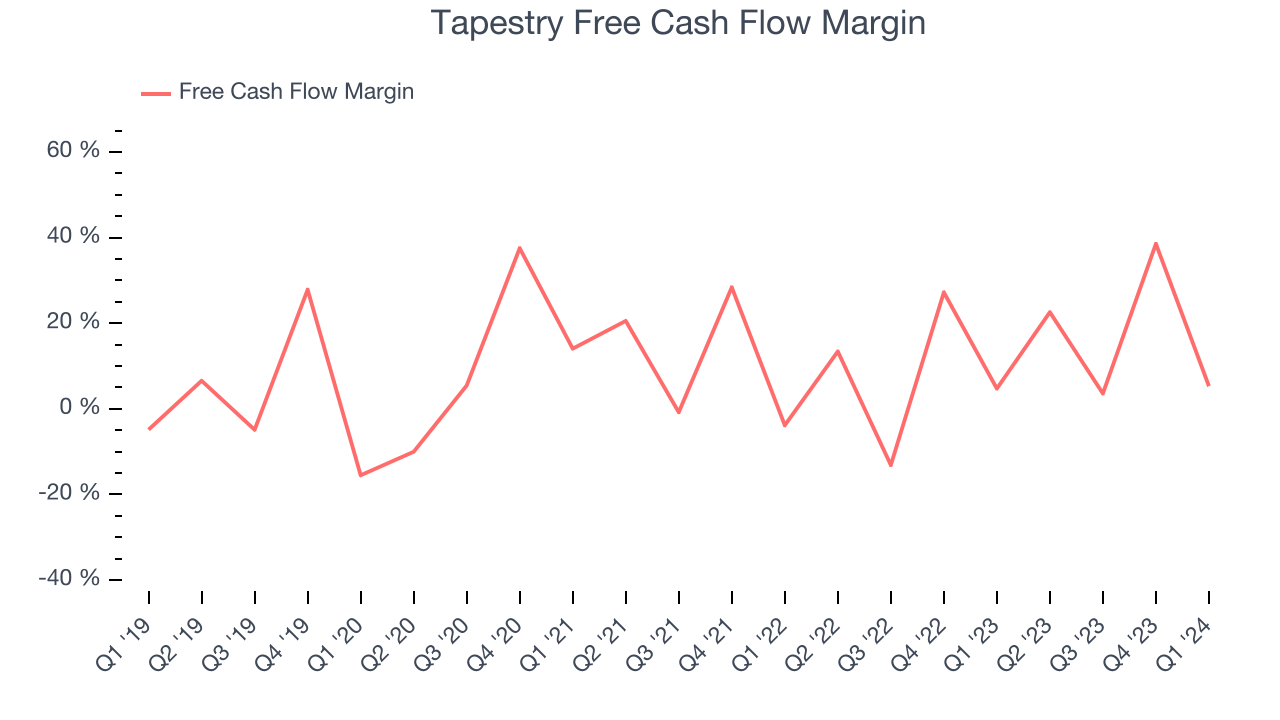Luxury fashion conglomerate Tapestry (NYSE:TPR) fell short of analysts' expectations in Q1 CY2024, with revenue down 1.8% year on year to $1.48 billion. The company's full-year revenue guidance of $6.6 billion at the midpoint also came in 2% below analysts' estimates. It made a GAAP profit of $0.60 per share, down from its profit of $0.78 per share in the same quarter last year.
Is now the time to buy Tapestry? Find out by accessing our full research report, it's free.
Tapestry (TPR) Q1 CY2024 Highlights:
- Revenue: $1.48 billion vs analyst estimates of $1.50 billion (1.1% miss)
- EPS: $0.60 vs analyst expectations of $0.63 (5.2% miss)
- The company dropped its revenue guidance for the full year from $6.7 billion to $6.6 billion at the midpoint, a 1.5% decrease
- Gross Margin (GAAP): 74.7%, up from 72.8% in the same quarter last year
- Free Cash Flow of $78.8 million, down 90.2% from the previous quarter
- Market Capitalization: $8.94 billion
Joanne Crevoiserat, Chief Executive Officer of Tapestry, Inc., said, “Our third quarter earnings results outperformed expectations, reflecting our unwavering commitment to disciplined brand building and operational excellence. Our talented global teams continued to advance our long-term initiatives, fueling innovation and consumer connections, while successfully harnessing the power of our customer engagement platform to navigate the dynamic backdrop with focus and agility. Moving forward, we are confident in our vision for the future and the significant runway to drive sustainable growth and shareholder value.”
Originally founded as Coach, Tapestry (NYSE:TPR) is an American fashion conglomerate with a portfolio of luxury brands offering high-quality accessories and fashion products.
Apparel, Accessories and Luxury Goods
Within apparel and accessories, not only do styles change more frequently today than decades past as fads travel through social media and the internet but consumers are also shifting the way they buy their goods, favoring omnichannel and e-commerce experiences. Some apparel, accessories, and luxury goods companies have made concerted efforts to adapt while those who are slower to move may fall behind.
Sales Growth
Reviewing a company's long-term performance can reveal insights into its business quality. Any business can have short-term success, but a top-tier one sustains growth for years. Tapestry's annualized revenue growth rate of 2.2% over the last five years was weak for a consumer discretionary business.  Within consumer discretionary, product cycles are short and revenue can be hit-driven due to rapidly changing trends. That's why we also follow short-term performance. Tapestry's recent history shines a dimmer light on the company as its revenue was flat over the last two years.
Within consumer discretionary, product cycles are short and revenue can be hit-driven due to rapidly changing trends. That's why we also follow short-term performance. Tapestry's recent history shines a dimmer light on the company as its revenue was flat over the last two years.
Tapestry also reports sales performance excluding currency movements, which are outside the company’s control and not indicative of demand. Over the last two years, its constant currency sales averaged 2.6% year-on-year growth. Because this number is higher than its revenue growth during the same period, we can see that foreign exchange rates have been a headwind for Tapestry. 
This quarter, Tapestry missed Wall Street's estimates and reported a rather uninspiring 1.8% year-on-year revenue decline, generating $1.48 billion of revenue. Looking ahead, Wall Street expects sales to grow 3.1% over the next 12 months, an acceleration from this quarter.
Unless you’ve been living under a rock, it should be obvious by now that generative AI is going to have a huge impact on how large corporations do business. While Nvidia and AMD are trading close to all-time highs, we prefer a lesser-known (but still profitable) semiconductor stock benefitting from the rise of AI. Click here to access our free report on our favorite semiconductor growth story.
Cash Is King
Although earnings are undoubtedly valuable for assessing company performance, we believe cash is king because you can't use accounting profits to pay the bills.
Over the last two years, Tapestry has shown solid cash profitability, giving it the flexibility to reinvest or return capital to investors. The company's free cash flow margin has averaged 14.6%, above the broader consumer discretionary sector.

Tapestry's free cash flow came in at $78.8 million in Q1, equivalent to a 5.3% margin and up 10.1% year on year. Over the next year, analysts predict Tapestry's cash profitability will fall. Their consensus estimates imply its LTM free cash flow margin of 19.4% will decrease to 15%.
Key Takeaways from Tapestry's Q1 Results
It was great to see Tapestry's strong earnings forecast for the full year, which exceeded analysts' expectations. On the other hand, its full-year revenue guidance missed and its EPS fell short of Wall Street's estimates. Overall, this was a bad quarter for Tapestry. The company is down 3.9% on the results and currently trades at $37.48 per share.
Tapestry may have had a tough quarter, but does that actually create an opportunity to invest right now? When making that decision, it's important to consider its valuation, business qualities, as well as what has happened in the latest quarter. We cover that in our actionable full research report which you can read here, it's free.
